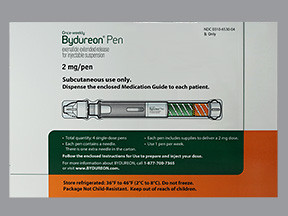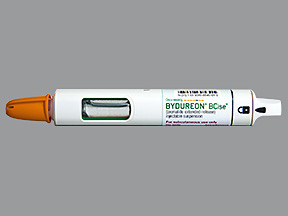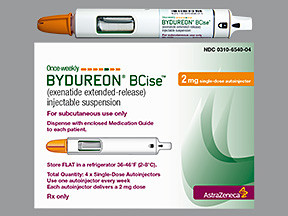EXENATIDE EXTENDED-RELEASE - INJECTION
PHONETIC PRONUNCIATION: (ex-EN-a-tide)
COMMON BRAND NAME(S): Bydureon
GENERIC NAME(S): exenatide microspheres
Uses
USES: Exenatide is used either alone or with other medications, and with a proper diet and exercise program, to control high blood sugar in people with type 2 diabetes. Controlling high blood sugar helps prevent kidney damage, blindness, nerve problems, loss of limbs, and sexual function problems. Proper control of diabetes may also lessen your risk of a heart attack or stroke. Exenatide is similar to a natural hormone in your body (incretin). It works by causing insulin release in response to high sugar (such as after a meal) and decreasing the amount of sugar your liver makes. Exenatide is not a substitute for insulin if you require insulin treatment.
How to use EXENATIDE EXTENDED-RELEASE - INJECTION
HOW TO USE: Read the Medication Guide and the Instructions For Use Leaflet provided by your pharmacist before you start using exenatide and each time you get a refill. Learn all preparation and usage instructions. If you have any questions, ask your doctor or pharmacist. Before using, check this product visually for particles or discoloration. If either is present, do not use the liquid. Before injecting each dose, clean the injection site with rubbing alcohol. Change the injection site each week to lessen injury under the skin. Inject this medication under the skin in the thigh, abdomen, or upper arm as directed by your doctor, usually once every 7 days. It may be used with or without meals. If you are using insulin at the same time as exenatide, give exenatide and insulin as separate injections. Do not mix them. You may inject these medications in the same area of the body, but the injection sites should not be next to each other. Use this medication regularly to get the most benefit from it. Remember to use it every 7 days. It may help to mark your calendar with a reminder. Carefully follow the medication treatment plan, meal plan, and exercise program your doctor has recommended. Learn how to store and discard medical supplies safely. Consult your pharmacist. Tell your doctor if your condition does not improve or if it worsens (such as if your blood sugar remains high or increases).
Side Effects
Precautions
Interactions
Overdose
Images
Reviews
Faq for EXENATIDE EXTENDED-RELEASE - INJECTION
Exenatide extended-release injection is used to improve blood sugar control in adults with type 2 diabetes.
Exenatide extended-release injection belongs to a class of drugs called incretin mimetics. It works by mimicking the effects of a hormone called GLP-1, which helps to lower blood sugar levels.
Exenatide extended-release injection is given as a subcutaneous injection once a week. It is available in pre-filled pens or syringes.
Common side effects of exenatide extended-release injection include nausea, vomiting, diarrhea, headache, and injection site reactions. These side effects usually improve over time.
Exenatide extended-release injection has been shown to promote weight loss in some individuals. However, it is primarily used for blood sugar control in people with type 2 diabetes.
Yes, exenatide extended-release injection can be used alone or in combination with other diabetes medications, such as metformin, sulfonylureas, or insulin, depending on individual treatment needs.
Exenatide extended-release injection starts lowering blood sugar levels shortly after the first dose, but its full effect may take several weeks.
Exenatide extended-release injection is not recommended for use during pregnancy. It is important to discuss the risks and benefits with your healthcare provider if you are planning pregnancy or become pregnant while on this medication.
Exenatide extended-release injection may increase the risk of developing thyroid tumors in rats, so it should be used with caution in individuals with a history of thyroid cancer. It should also be used cautiously in people with kidney problems.
Warning
WARNING: This medication can cause a certain type of thyroid tumor (thyroid C-cell tumors) in rats. It is unknown if this medication can cause similar tumors in humans. Talk with your doctor about the benefits and risks of treatment with this medication. Do not use this medication if you have a personal/family history of a certain type of cancer (medullary thyroid carcinoma) or a certain inherited disease (multiple endocrine neoplasia syndrome type 2 or MEN 2). While using this medication, tell your doctor right away if you notice any signs of thyroid tumors, including an unusual growth or lump in the neck, difficulty swallowing, shortness of breath, unusual/lasting hoarseness.
Disclaimer
IMPORTANT: HOW TO USE THIS INFORMATION: This is a summary and does NOT have all possible information about this product. This information does not assure that this product is safe, effective, or appropriate for you. This information is not individual medical advice and does not substitute for the advice of your health care professional. Always ask your health care professional for complete information about this product and your specific health needs.




No Reviews Yet